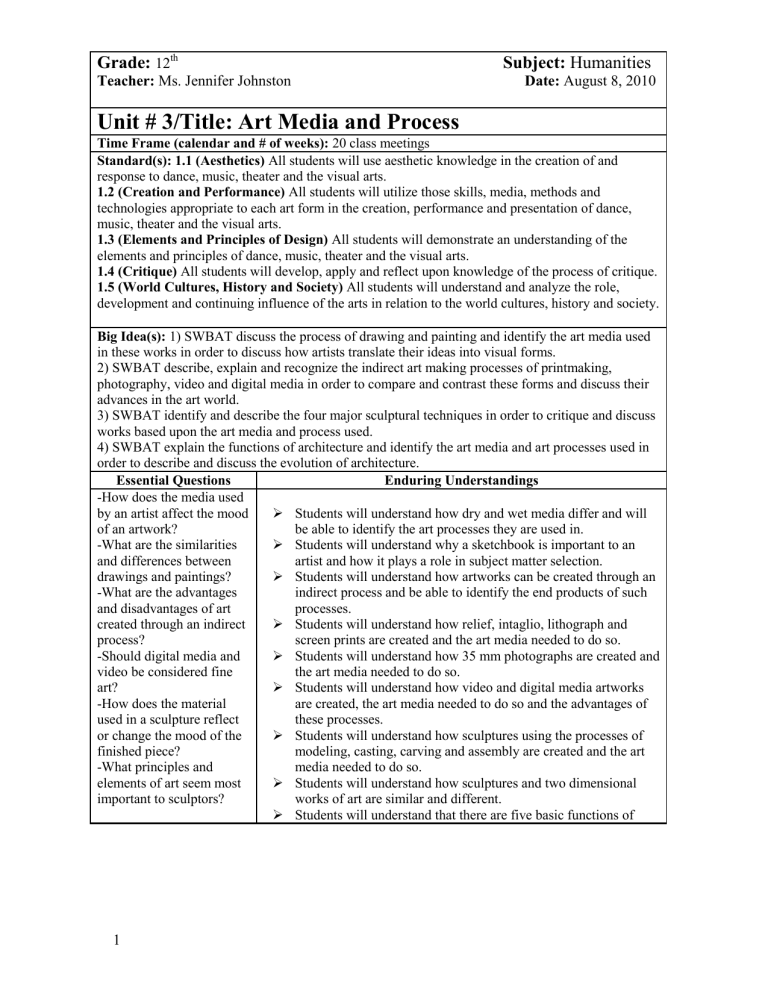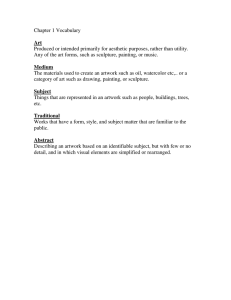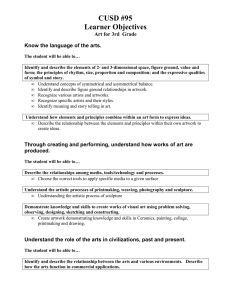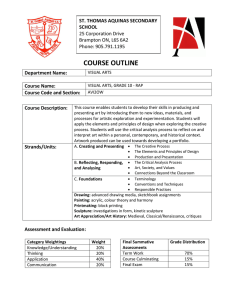
Grade: 12th Teacher: Ms. Jennifer Johnston Subject: Humanities Date: August 8, 2010 Unit # 3/Title: Art Media and Process Time Frame (calendar and # of weeks): 20 class meetings Standard(s): 1.1 (Aesthetics) All students will use aesthetic knowledge in the creation of and response to dance, music, theater and the visual arts. 1.2 (Creation and Performance) All students will utilize those skills, media, methods and technologies appropriate to each art form in the creation, performance and presentation of dance, music, theater and the visual arts. 1.3 (Elements and Principles of Design) All students will demonstrate an understanding of the elements and principles of dance, music, theater and the visual arts. 1.4 (Critique) All students will develop, apply and reflect upon knowledge of the process of critique. 1.5 (World Cultures, History and Society) All students will understand and analyze the role, development and continuing influence of the arts in relation to the world cultures, history and society. Big Idea(s): 1) SWBAT discuss the process of drawing and painting and identify the art media used in these works in order to discuss how artists translate their ideas into visual forms. 2) SWBAT describe, explain and recognize the indirect art making processes of printmaking, photography, video and digital media in order to compare and contrast these forms and discuss their advances in the art world. 3) SWBAT identify and describe the four major sculptural techniques in order to critique and discuss works based upon the art media and process used. 4) SWBAT explain the functions of architecture and identify the art media and art processes used in order to describe and discuss the evolution of architecture. Essential Questions Enduring Understandings -How does the media used by an artist affect the mood Students will understand how dry and wet media differ and will of an artwork? be able to identify the art processes they are used in. -What are the similarities Students will understand why a sketchbook is important to an and differences between artist and how it plays a role in subject matter selection. drawings and paintings? Students will understand how artworks can be created through an -What are the advantages indirect process and be able to identify the end products of such and disadvantages of art processes. created through an indirect Students will understand how relief, intaglio, lithograph and process? screen prints are created and the art media needed to do so. -Should digital media and Students will understand how 35 mm photographs are created and video be considered fine the art media needed to do so. art? Students will understand how video and digital media artworks -How does the material are created, the art media needed to do so and the advantages of used in a sculpture reflect these processes. or change the mood of the Students will understand how sculptures using the processes of finished piece? modeling, casting, carving and assembly are created and the art -What principles and media needed to do so. elements of art seem most Students will understand how sculptures and two dimensional important to sculptors? works of art are similar and different. Students will understand that there are five basic functions of 1 -Why is architecture considered a fine art like that of sculpture and painting? -How do the building materials and construction methods used affect the overall design of a building? architecture that all structures can be categorized into. Students will understand how architectural materials and processes have evolved from prehistoric times to today. Students will understand how modern architectural structures are created and the art media used to do so. Areas of Focus Suggested Instructional Strategies 2 Prioritized CPIs 1.1 A (Knowledge) 1. Formulate responses to fundamental elements within an art form, based on observation, using the domain-specific terminology of that art form. 2. Discern the value of works of art, based on historical significance, craftsmanship, cultural context, and originality using appropriate domain specific terminology. 3. Determine how historical responses affect the evolution of various artistic styles, trends and movements in art forms from classicism to postmodernism. 1.1 B (Skills) 1. Compose specific and metaphoric cultural messages in works of art, using contemporary methodologies. 2. Formulate a personal philosophy or individual statement on the meaning(s) of art. 1.2 D (Visual Arts) 1. Interpret themes using symbolism, allegory, or irony through the production of two or threedimensional art. 2. Perform various methods and techniques used in the production of works of art. 3. Produce an original body of work in one or more mediums that demonstrates mastery of methods and techniques. 4. Outline a variety of pathways and the requisite training for careers in the visual arts. 3 TOPIC/TEXT: Drawing and Painting Tier 1 Activities/Strategies (Knowledge/Comprehension) 1) Drawing on experience questions: Do you like to draw? What kinds of subjects do you/have you drawn? Have you ever used paint to create an artwork? Where do you think artist get their ideas from? 2)Vocabulary definitions: art media, wet media, still life, pigment, binder, solvent 3) Key point notes and artwork discussion questions: Drawing media and process, painting media and process, dry vs. wet media, subject matter categories, sketchbooks 4)Lesson guided reading questions 5) Lesson main idea though organizing chart 6) Drawing and painting media and tools classification chart 7) End of lesson quiz: fill in the blank and artwork picture identifications. Tier 2 Activities/Strategies (Application/Analysis) 1) Contour and blind contour drawing activity: Creating of contour and blind contour line drawings of shoes. Reflection on activity and evaluation of exercise. 2) Finding diverse art media in your closet and abroad activity: Review art media and processes important to various cultures (feathers, shells, tie dye), Look for examples of such techniques of items in your own closet and home. Share findings with class, select top four most common and make a poster displaying the art media/processes and their cultural significance. Tier 3 Activities/Strategies (Synthesis/Evaluation) 1) Perceptual awareness activity: Students will individually journal and sketch for five days examples of the elements and principles of art seen in their travels. Students will then come together as a small group to compare items and look for the top three in common or of interest. They will take the writings and sketches and create a unified artwork representing those three ideas. Finished works will be presented to the class. 2) Artist trading card: baseball card size artwork created reflecting what the student takes away from the lesson. Will be kept along with other cards created throughout the semester in protective sleeves to be viewed and traded at the end of the semester. 1.3 D (Visual Arts) 1. Compare and contrast innovative applications of the elements of art and principles of design. 2. Analyze how a literary, musical, theatrical, and/or dance composition can provide inspiration for a work of art. 1.4 A (Knowledge) 1. Examine the artwork from a variety of historical periods in both western and non-western culture(s). 2. Categorize the artistic subject, the formal structure, and the principal elements of art used in exemplary works of art. 3. Determine the influence of tradition on arts experience, as an arts creator, performer, and consumer. 1.4 B (Skills) 1. Develop criteria for evaluating art in a specific domain and use the criteria to evaluate one’s personal work and that of their peers, using positive commentary for critique. 2. Provide examples of how critique may affect the creation and/or modification of an existing or new work of art. 1.5 A (Knowledge) 1. Parallel historical events and artistic development found in dance, music, theater, and visual art. 2. Summarize and reflect upon how various art forms and cultural resources preserve cultural heritage and influence contemporary art. 4 TOPIC/TEXT: Printmaking, Photography, Video and Digital Media Tier 1 Activities/Strategies (Knowledge/Comprehension) 1) Drawing on experience questions: Have you ever made a print using a sponge dipped in paint? What other items have you used to make prints? Have you ever taken pictures or made home movies with a video camera? 2)Vocabulary definitions: relief printing, intaglio, burin, lithography, screen printing, serigraph, photography, digital media 3) Key point notes and artwork discussion questions: Four types of printmaking and their processes, photography process, video and digital media processes and end products 4) Main topics of lesson graphic organizer 5)Lesson guided reading questions 6) End of lesson quiz: matching and artwork identifications in picture format. Tier 2 Activities/Strategies (Application/Analysis) 1) Rufino Tamayo Toast to the Sun artwork analysis: group and individual critique questions (describe, analyze, interpret, judge); biography reading, annotation and questions 2) Music video analysis activity: Students will view a video of their choice and critique it on use of music, dance, theater/acting, setting/painting, photography and video. This information will help in a larger project at the end of the unit. Tier 3 Activities/Strategies (Synthesis/Evaluation) 1) Nature relief print: students will create contour drawings of objects from nature. The selected drawing will be traced onto a piece of foam. The students will then use traditional printing tools and methods to create prints of the plate. Analysis of the elements and principles of art will take place as well as a write up describing the project process from start to finish. 2) Artist trading card: baseball card size artwork created reflecting what the student takes away from the lesson. Will be kept along with other cards created throughout the semester in protective sleeves to be viewed and traded at the end of the semester. TOPIC/TEXT: Sculpture 1.5 B (Skills) 1. Evaluate the impact of innovations in the arts from various historical periods in works of dance, music, theater, and visual art stylistically representative of the times. 2. Compare and contrast the stylistic characteristics of a given historical period through dance, music, theater, and visual art. Tier 1 Activities/Strategies (Knowledge/Comprehension) 1) Drawing on experience questions: Have you ever molded something out of clay? Have you ever seen an ice sculpture or sand castle? What other types of sculpture have you seen? What types of tools do you need to create a sculpture? 2)Vocabulary definitions: bas relief, high relief, sculpture in the round, modeling, carving, casting, assembly, kinetic art 3) Key point notes and artwork discussion questions: relief sculpture, sculpture in the round, modeling, carving, casting, assembly, kinetic art 4) Sculpture types, materials and processes thought organizing chart 5)Lesson guided reading questions 6) Art fair sculpture identification worksheet: Students will be given a small write up about sculptures entered in a student art fair, using the information they will have to determine the type of sculpture, art process, art media, and find a correlating sculptural piece in their textbook. 7) End of lesson quiz: matching and artwork identifications in picture format. Tier 2 Activities/Strategies (Application/Analysis) 1) “And the winner is…” activity: Students will select one sculpture discussed during the lesson and another of their choice that uses the same sculpting process from the textbook. They will compare and contrast the works based upon materials and subject matter. The student will then pick a winner for that sculpting category and justify why. 2) Group posters of the casting process: Students will work in small groups to create posters that explain the steps used in creating a cast sculpture. Each group will have to illustrate their assigned step or find pictures from the internet and incorporate in writing what takes place during that step. The finished works will then be arranged in order by the students and hung up. Tier 3 Activities/Strategies (Synthesis/Evaluation) 1) “If sculptures could talk” writing activity: Students will select a sculpture from their text and record the artist, art period/culture, art process and art media. They will identify where it is currently located and point out what are its most impressive features. Students will then write about what they think the sculpture would say if it could speak to its viewers. The finished stories will be typed up and read to the class. Colored printouts of the works will be displayed around the classroom like as if in a museum. The class will have to try and match up the stories with the works. 2) Artist trading card: baseball card size artwork created reflecting what the student takes away from the lesson. Will be kept along with other cards created throughout the semester in protective sleeves to be viewed and traded at the end of the semester. 5 TOPIC/TEXT: Architecture Tier 1 Activities/Strategies (Knowledge/Comprehension) 1) Drawing on experience questions: Have you ever built a tower out of blocks? Do you have a design for your dream home? What materials would you need to build a skyscraper? What does an architect do? 2)Vocabulary definitions: architecture, tensile strength, barrel vault, groin vault, dome 3) Key point notes and artwork discussion questions: beginnings of architecture, five functions, evolution of construction and materials, architectural support systems, modern construction processes and materials 4) Architecture materials and construction processes thought organizer 5)Lesson guided reading questions 6) Architecture functions and materials classification chart 7) End of lesson quiz: true/false and artwork identifications in picture format. Tier 2 Activities/Strategies (Application/Analysis) 1) School addition proposal: If you could add another room to the school where would it be? What would it be used for? What materials would you need to construct it? How would you go about constructing it? (financing? Workers? ) How would the finished space look when inside? How would the space look from the outside? Who would benefit from the new space? Share finished proposal with fellow students. 2) Architecture in your community activity: Select three buildings in your community and describe their function, art medium used, construction process, what stands out the most about the structure, what would you change about the structure, does the design of the structure work well for its purpose? Tier 3 Activities/Strategies (Synthesis/Evaluation) 1) Team balloon framing activity: Students will work in groups to build a structure skeleton in the balloon framing format using spaghetti and marshmallows. They will not be allowed to verbally communicate or write down any information. The final structures will be tested for durability and height. Students will record this information down as well as their plan of attack, what worked well and what didn’t. 2) Artist trading card: baseball card size artwork created reflecting what the student takes away from the lesson. Will be kept along with other cards created throughout the semester in protective sleeves to be viewed and traded at the end of the semester. 6 Performance Tasks/Assessments Still Life Contour Drawing Transformed Into a Painting and Sculpture: Students will use their contour drawing still life from the last unit as the subject for this project. They will create a painted version of the drawing by tracing the original work onto another sheet of paper and painting in the piece using bold colors to help further abstract the piece so there is more of a focus on shape and color. Students will create a relief sculpture of the contour drawing by taking the basic shapes of each object, tracing and cutting them out of foam board. These pieces will then be painted in varying shades of grey. The background will be painted a solid color of their choice on cardboard. The foam board pieces will then be arranged in overlapping patterns on the cardboard and glued down. The three still life versions will then be mounted on large poster board and credit line cards will be created for each piece. A self-critique form will be completed about the overall project. School Personal Pledge Music Video: Students will work in groups of four to plan, produce and film a music video using the school’s personal pledge as the song. They can create backing music, rap, sing, use random student clip etc. They must plan out the whole production by writing a script, creating a storyboard of scenes, planning wardrobe and props, selecting sets as well as who will be the talent and who will film. The final works will be shown at a class viewing party and critiqued at the end. Cardboard Sculptures: Students will start off by creating small relief sculptures made up of small cut out shapes of cardboard on larger cardboard bases. They will need to complete at least three of these smaller pieces. These small artworks will then be assembled into a sculpture in the round by cutting slits into each piece and connecting them. The 3-d works will then be painted a single color of choice. Students will then write about the piece, giving it a credit line card, identifying the art process used, elements and principles of art used and what was the inspiration for the piece. Students will then complete a self-critique on the work. Environmental art sculpture project: The works of Calder, Haring and Oldenburg will be discussed and their selection of setting for their sculptures. Students will work in groups of four to create an outdoor sculpture proposal and model. Students will first select a location on school grounds for the piece and take a picture of the location. They will then brainstorm on sculpture ideas and come up with one to focus on. They will write a proposal explaining its purpose, how it will enhance the school environment, the materials needed, the processes used to construct it and an approximate time line for the project. Students will then take this information and create a presentation board that includes the written proposal, site picture and sketches or a model of the finished piece. Students will present their finished proposals to the class. 7 Written Comprehensive Test: Students will be tested on the information from the unit in the following format: true/false, fill in the blank, critical thinking short answer and artwork picture identifications. Resources: Text: Art in Focus Technology: Laptop and projector for teacher, Lap tops for students, camera, video camera Video: Night at the Museum II DVD (for if sculpture could talk activity) Lesson wide worksheets: Drawing on experience starter question sheets for each lesson, Vocabulary sheets for each lesson, Key point and art work discussion questions packets for each lesson, Guided reading questions for each lesson, Major topic thought organizers for each lesson Individual activity worksheets: Art in your home worksheet, Drawing and painting media and tools classification chart, Music video analysis worksheet and project outline, Perceptual awareness worksheet, Art fair sculpture identification worksheet, If sculptures could talk writing outline, Architecture functions and materials classification chart, Architecture in your community worksheet, From painting to sculpture worksheet, Environmental sculpture worksheet and project outline, music video project outline Artwork print: Toast to the Sun by Rufino Tamayo - Rufino Tamayo critique questions and short biography with questions Art supplies: 12 x 18”, 9x12”white drawing paper, pencils, colored pencils, fine and regular tip markers, crayons, rulers, colored construction paper, poster board, acrylic paint, water cups, paint palettes, round and flat brushes, glue, scissors, still life contour drawings, black Sharpies markers, cardboard, foam board, spaghetti, marshmallows, fan, clay, collage materials, printing ink, foam plates, brayers, objects from nature, student artwork samples, Blank trading cards Written assessments: Project grading rubrics, End of lesson quizzes (4), End of unit test 8





